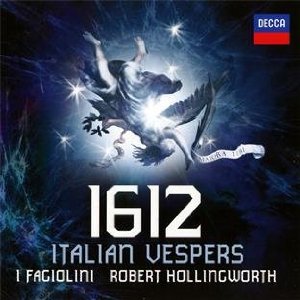I Fagiolini/Robert Hollingworth: 1612 Italian Vespers (Decca)
Here's a gimmick I can get behind. Last year, I Fagiolini's Decca debut presented the first recording of Striggio's Mass in 40 Parts and was quite successful by the standards of Renaissance choral albums. In a world where conductors record the same symphony four or five times, focusing on "new" old repertoire is quite refreshing. For their follow-up, the group and founder/director Robert Hollingworth give some more major works their recording premieres, this time focusing on Venetian composers on the cusp between the Renaissance and the Baroque.
The more famous composer to have works returned to the light of day is Giovanni Gabrieli (c.1554/7-1617), whose Magnificat for seven choirs and motet In ecclesiis have been reconstructed by Hugh Keyte from incomplete or truncated sources. They are presented in the context of a Vespers service mostly otherwise drawn from five previously unrecorded four-choir Vesper Psalms, published 400 years ago,and two other works by Lodovico Grossi da Viadana (ca. 1560-1627). In the Psalms, two of the choirs are assigned to brass instruments, a fairly common practice at the time; Venetian music is all about pomp and powerful sonorities, and these works all deliver in full.
Also mixed in are plainchant antiphons, instrumental interludes by Bartolomeo Barbarino (c.1568-c.1617), Claudio Monteverdi (1567-1643), and Andrea Gabrieli (1532/3-1585), Monteverdi's virtuoso motet for bass vocalist Ab aeterno ordinate sum, and choral works by Giovanni Pierluigi da Palestrina (1525/6-1594), and Francesco Soriano (1548/9-1621). The Palestrina, Quae est ista, is in an earlier style, just a five-part/one-choir a cappella piece, and sticks out like a sore thumb even amid the sort of whiplash this kind of simulation of an actual or at least plausibly possible service always causes with its alternation of plainchant with big, ornate pieces (yes, it's authentic, but that doesn't make it artistic).
The occasion is the Second Vespers of the feast of Our Lady of the Most Holy Rosary, in commemoration of the 1571 victory over the Turks in the Battle of Lepanto, of which there is some documentation. Not enough to really justify the inclusion of In ecclesiis, but what the heck, at least it fits stylistically, and Keyte's speculative polychoral expansion of the one-choir version that's come down to us certainly deserves to be heard. The military commemoration aspect of the occasion brings the inclusion of some war-like music, both choral and instrumental, that's quite dramatic.
The English Cornett and Sackbut Ensemble provides the brass, there's a small authentic-instrument string section at times, three organists (James Johnstone, Catherine Pierron, David Roblou) take turns starring on instrumentals and -- with an assortment of three organs -- anchor the continuo (along with lute [David Miller] and theorbo [Miller and Lynda Sayce). The plainchant is sung by De Profundis (Cambridge) rather than I Fagiolini. All concerned sound fabulous, and whatever cynicism I may have about the overall service-recreation concept, the music is undeniably attractive and historically important in spite of the centuries of neglect some of it has suffered. Nobody who enjoys Venetian polychoral music should be without this album.

